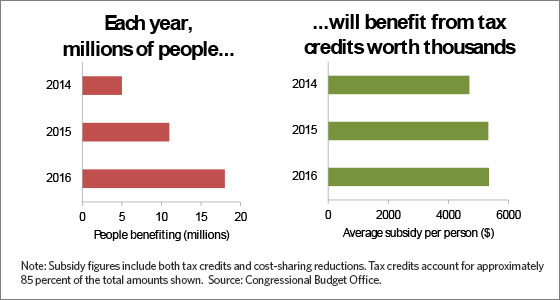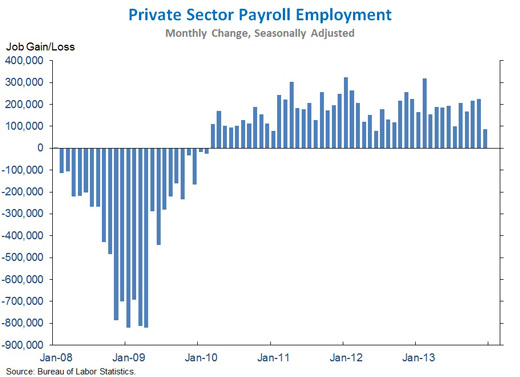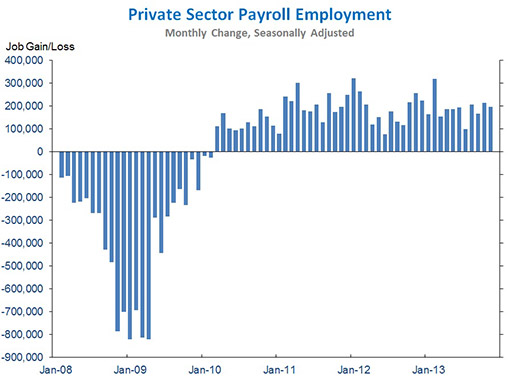Council of Economic Advisers Blog
The Employment Situation in January
Posted by on February 7, 2014 at 9:30 AM ESTToday’s report is another reminder of both the progress that has been made and the challenges that remain. Businesses have now added 8.5 million jobs over the last 47 months and the unemployment rate ticked down to its lowest level in more than five years. But the economy is still healing from the Great Recession and steps are still needed to expand economic opportunity. Given the elevated long-term unemployment rate, extending emergency unemployment benefits for the 1.7 million workers who lost them is critical. At the same time, the President will continue to focus on action, both pushing forward on priorities with Congress and using his pen and his phone to expand opportunity and growth.
FIVE KEY POINTS IN TODAY’S REPORT FROM THE BUREAU OF LABOR STATISTICS
1. The private sector has added 8.5 million jobs in 47 consecutive months of job growth. Today we learned that total nonfarm payroll employment rose by 113,000 in January, due to a 142,000 increase in private employment together with a 29,000 decline in government jobs. Private sector job growth was revised up for November (to 272,000) and December (to 89,000) so that over the past twelve months, private employment has risen by 2.3 million, or an average of 191,000 per month. These figures account for several data revisions released today, including benchmarking the survey-based data to more comprehensive tax records, updating the seasonal adjustment factors, and reclassifying a handful of industries.

2. While the overall unemployment rate continues to fall, it still remains unacceptably high, reflecting more than 3.6 million long-term unemployed. The unemployment rate has fallen 1.3 percentage point in the last 12 months, and fell in January 0.1 percentage point, even as the labor force participation rate rose 0.2 percentage point. But as of January 2014, persons unemployed 27 weeks or more represent 2.3 percent of the labor force, more than double its average prior to the recession. These figures provide a stark reminder that despite the progress that has been made, the after-effects of the recession still linger and are creating hardship for many families. For this reason, the President has called on Congress to reinstate the extended unemployment insurance benefits that expired at the end of 2013, and in the absence of congressional action, the President will use his own authority to forge ahead with efforts to help connect the long-term unemployed with new jobs. Last week, the President announced commitments from over 300 companies – including 80 of the nation’s largest businesses – to adhere to a new set of best practices that will ensure recruiting processes do not disadvantage people who have been out of work, along with new funding for partnerships that connect the long-term unemployed to jobs.
Learn more about , EconomySix Economic Benefits of the Affordable Care Act
Posted by on February 6, 2014 at 12:47 PM ESTThis week has seen the release of a Congressional Budget Office (CBO) analysis that refuted claims by opponents of the Affordable Care Act (ACA) that it is a “job killer” and demonstrated that, by giving families more options for obtaining affordable health insurance outside the workplace, the ACA will make it easier for people take a risk and start a business, take time out of the labor force to raise a family, or retire when they are ready.
As CBO made clear, however, its analysis was not a comprehensive analysis of how the ACA will affect the labor market in particular or the economy as a whole. This blog post illustrates six ways that the ACA is helping the labor market, laying the foundation for future economic growth, and improving families’ financial security and well-being.
1.Putting more money in families’ pockets, boosting demand, and bringing down unemployment today. As of January 1, more than 2 million people had selected a plan in the health insurance marketplace, and nearly 80 percent of those people will – thanks to the ACA – benefit from tax credits to help pay their premiums. All told, the Congressional Budget Office estimates that over the entirety of 2014, 5 million people will benefit from premium tax credits and help with cost-sharing averaging $4,700 per person. In 2015, 11 million people are estimated to benefit, rising to 19 million in 2016. Many millions more will gain affordable health insurance coverage through Medicaid.
These provisions of the ACA make it easier for families to access health care services and to meet other pressing needs, which will increase the demand for goods and services throughout the economy at a time when the unemployment rate is still elevated. For this reason, as CBO Director Doug Elmendorf testified, the ACA “spurs employment and would reduce unemployment over the next few years.” The ACA is thus – today – helping ensure that every American who wants a job can find one.

2. Helping slow the growth of health care costs, boosting hiring in the near term, and bolstering workers’ paychecks. The United States is currently experiencing a historic slowdown in the growth of health care costs. From 2010 to 2012 real per-capita health spending grew at an average annual rate of just 1.1 percent, and preliminary data and projections imply that this slow growth continued in 2013. The spending growth rates recorded over the last few years are the slowest on record, and less than one-third the long-term historical average of 4.6 percent that stretches back to 1960.
Learn more about Economy, Health CareAdvance Estimate of GDP for the Fourth Quarter of 2013
Posted by on January 30, 2014 at 9:33 AM ESTEconomic growth was solid in the fourth quarter, a testament to the resilience of American businesses and families. The private sector’s strong performance in the fourth quarter caps off its fastest year of growth since 2003. And over the four quarters of 2013, real GDP grew 2.7 percent, its strongest rate in three years. Nevertheless, the unemployment rate is still unacceptably high, and too many Americans are still looking for a job and fighting to make ends meet. In his State of the Union address on Tuesday night, President Obama outlined his plans to build on the progress made to date and ensure 2014 is a year of action, with steps to increase growth, create new jobs, and expand economic opportunity.
FIVE KEY POINTS IN TODAY’S REPORT FROM THE BUREAU OF ECONOMIC ANALYSIS
1. Real gross domestic product rose at a solid 3.2 percent annual rate in the fourth quarter, the 11th consecutive quarter of growth. Looking at the various components of GDP, growth in consumer spending picked up from the previous quarter, as did exports, business investment was in line with its recent performance, but Federal spending fell sharply, and housing posted its first quarterly decline since 2010. In the last two quarters economic growth accelerated to a 3.7 percent annual rate and over the four quarters of 2013, real GDP grew 2.7 percent, up from 2.0 percent in 2012. (Note that economists generally prefer to measure growth on a Q4/Q4 basis because that reflects what happened to the economy just in 2013, the alternative annual measure of growth also places considerable weight on what happened to the economy in 2012 and thus does not provide as meaningful a measure.)
 Learn more about Economy
Learn more about EconomyThe Employment Situation in December
Posted by on January 10, 2014 at 9:40 AM ESTAs our economy continues to make progress, there's a lot more work to do. Though December’s job growth was less than expected, we continue to focus on the longer-term trend in the economy - 2.2 million private sector jobs added and a 1.2 percentage point decline in the unemployment rate over the course of 2013. Today’s numbers are also a reminder of the work that remains, especially on one of our nation’s most immediate and pressing challenges: long-term unemployment. Despite an abundance of evidence indicating that this challenge is far from solved, Congress allowed extended unemployment insurance to lapse at the end of 2013, cutting off a critical lifeline to those who lost a job through no fault of their own and are still searching for work. Several of the charts below—and the updated Council of Economic Advisers report available here—explain why today’s jobs numbers show that while we are making progress, extended unemployment insurance benefits remain necessary and should be the first order of business in 2014.
FIVE KEY POINTS IN TODAY’S REPORT FROM THE BUREAU OF LABOR STATISTICS
1. America’s resilient businesses have added jobs for 46 consecutive months, with private sector employment increasing by 8.2 million over that period. Today we learned that total nonfarm payroll employment rose by 74,000 in December, due to an 87,000 increase in private employment. Private sector job growth was revised up for October (to 217,000) and November (to 226,000) so that over the last three months, private employment has risen by an average of 177,000 per month. Policymakers should be doing everything they can to speed job creation. The Council of Economic Advisers estimates that extending the Emergency Unemployment Compensation (EUC) program through 2014 would lead to an additional 240,000 jobs over the course of the year, because the benefits sustain the purchasing power of recipients who support local businesses and their suppliers. This projection is similar to the central estimate released by the Congressional Budget Office.
 Learn more about , Economy
Learn more about , EconomyThe Economy in 2013
Posted by on December 19, 2013 at 1:00 PM ESTThe economy is finishing 2013 in a stronger place than where it began the year, though more work remains to grow the economy, create jobs, and strengthen the middle class. This is especially notable given the general fiscal environment, including the onset of the sequester in March, and the government shutdown and debt limit brinksmanship in October. The recent budget bill passed by Congress on a bipartisan basis will contribute to certainty, a better fiscal stance over the next year, and more funding for the critical ingredients of longer run growth. But more needs to be done, most immediately extending Unemployment Insurance benefits, and beyond that increasing investments to strengthen growth and making sure that growth is shared.
The slides below highlight the key themes and developments in the economy over the course of the year, and also touch on a few longer-term structural trends that continued to unfold in 2013 and will support growth into the future.
The strengthening of the economy over the course of 2013 is a testament to America’s resilient private sector and America’s workers. Businesses have added 8.1 million jobs over the past 45 months, and are on track to register the third consecutive year of job growth in excess of two million.
The growth rate of gross domestic product has risen for four straight quarters, and the private components of GDP have grown at a robust 3.7 percent annualized rate over the last two quarters. One of the biggest contributors to recent GDP growth has been the housing sector, which was the epicenter of the financial crisis but is bouncing back and has significant potential going forward.
There are also several emerging structural trends that supported growth in 2013 and will continue to play an important role in our economy. The United States is now the largest producer of oil and gas in world, passing Russia and Saudi Arabia, and for the first time since 1995, the United States is producing more oil domestically than it imports. A second, less widely appreciated trend is the dramatic slowdown in health care cost growth that in part reflects critical reforms under the Affordable Care Act. Slower health care cost growth means less pressure on employers and the federal budget and more take-home pay for families. Lastly, technological contributions such as cloud computing and mobile broadband and mobile devices continue to help the economy.
Learn more about , EconomyThe Employment Situation in November
Posted by on December 6, 2013 at 9:30 AM ESTWith solid job growth in November – in addition to strong data on manufacturing activity and auto sales – it is clear that the recovery continues to gain traction. Today’s report was yet another reminder of the resilience of America’s private sector following the disruptive government shutdown and debt limit brinksmanship in the first half of October. Nevertheless, today’s jobs numbers show that too many Americans who have been unemployed for 27 weeks or longer are still struggling to find jobs. That is why the President is calling on Congress to pass the extension of emergency unemployment insurance before it expires at the end of the year, just like they have always done when long-term unemployment remains elevated. The President also continues to work to increase overall growth while ensuring that growth is shared broadly in the form of higher wages and more mobility, which is why he is fighting for a minimum wage increase and expansion of educational opportunities.
FIVE KEY POINTS IN TODAY’S REPORT FROM THE BUREAU OF LABOR STATISTICS
1. America’s resilient businesses have added jobs for 45 consecutive months, with private sector employment increasing by more than 8 million over that period. Today we learned that total nonfarm payroll employment rose by 203,000 in November, with 196,000 of that increase in the private sector. Private sector job growth was revised up for September (to 168,000) and October (to 214,000) so that over the last three months, private employment has risen by an average of 193,000 per month.
 Learn more about , Economy
Learn more about , Economy
- &lsaquo previous
- …
- 8
- 9
- 10
- 11
- 12
- 13
- 14
- 15
- 16
- …
- next &rsaquo
White House Blogs
- The White House Blog
- Middle Class Task Force
- Council of Economic Advisers
- Council on Environmental Quality
- Council on Women and Girls
- Office of Intergovernmental Affairs
- Office of Management and Budget
- Office of Public Engagement
- Office of Science & Tech Policy
- Office of Urban Affairs
- Open Government
- Faith and Neighborhood Partnerships
- Social Innovation and Civic Participation
- US Trade Representative
- Office National Drug Control Policy
categories
- AIDS Policy
- Alaska
- Blueprint for an America Built to Last
- Budget
- Civil Rights
- Defense
- Disabilities
- Economy
- Education
- Energy and Environment
- Equal Pay
- Ethics
- Faith Based
- Fiscal Responsibility
- Foreign Policy
- Grab Bag
- Health Care
- Homeland Security
- Immigration
- Innovation Fellows
- Inside the White House
- Middle Class Security
- Open Government
- Poverty
- Rural
- Seniors and Social Security
- Service
- Social Innovation
- State of the Union
- Taxes
- Technology
- Urban Policy
- Veterans
- Violence Prevention
- White House Internships
- Women
- Working Families
- Additional Issues

